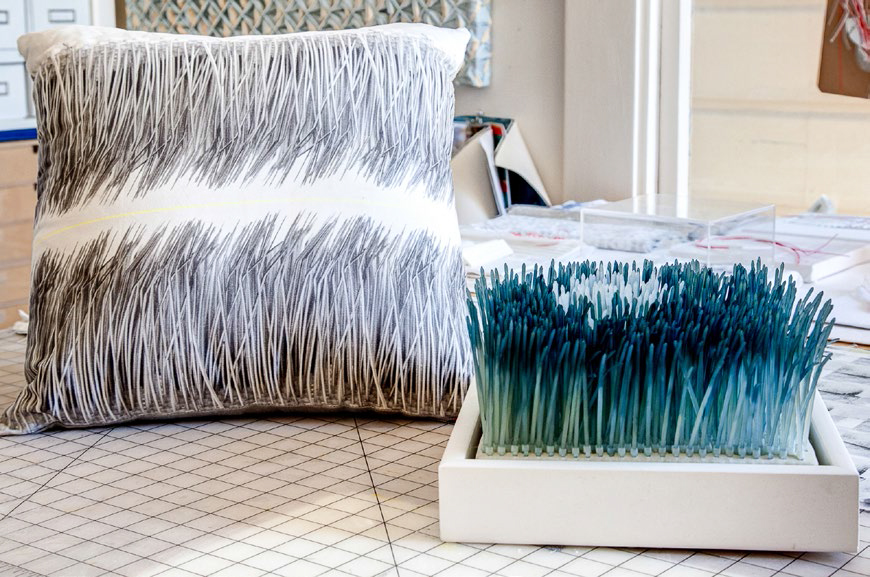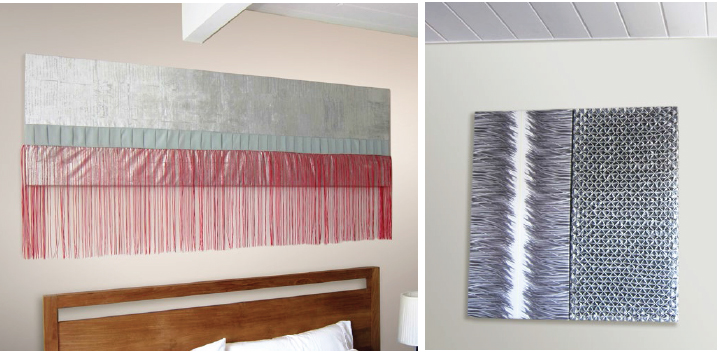Architecture in Fabric - Page 2
 |
 |
|
|
 |
|
|
 |
|
|
|
|
In some of her smocked pieces, viewers can make out the original imagery—with some attention. In other works, though, there might be no more than the memory of the image.
"They invite closer inspection, to appreciate the layers involved—from photography, then fabric manipulation, then printed over or photographed again, and re-imaged onto an ever-changing surface," artist and former art partner Leona Collins says of Ealish's work. "You simply have to touch the piece, and that's what I love as a fellow textile designer."
Yochum appreciates Ealish's skill. "I'm a big fan of craft, and not in a sense of arts and crafts, but that you actually are talented in what you are doing," he says. "That goes a long way with me."
Lea Feinstein, an artist and friend who has several pieces by Ealish in her Palo Alto Eichler, calls Ealish's work "architectural textiles."
"The large-scale smocked pieces, because of their combination of softness and rigidity, are architectural in spirit and speak to the architecture of the building," she says. "They look great in modern spaces."
"She takes pictures of fire escapes, and the shadows of fire escapes, and uses them. She responds to architecture," Feinstein says.
Ealish says she is influenced by architecture. "It just makes me think about scale, and it makes me think about proportion," she says. In fact, she traces her smocking to architecture—and to her time in Japan.
"[Switzerland-based architects] Herzog & de Meuron are responsible for that fact I do smocking, because they designed the Prada building in Tokyo." (The firm also designed the de Young.)
"It has concave and convex glass, and it really gives the impression of being padded," she says of the Prada, "and I was really inspired by it. I went back to Kyoto and started to recreate it in fabric. That's where I basically came up with the smocked thing."
As a technique, smocking is antique in terms of years but also in terms of attitude. It's painstaking, in the way inscribing an ancient alchemical treatise by hand was painstaking—and perhaps with some of the same meditative effects.
"When you look at this work that is so laborious—thousands of ties, so repetitious," curator Hanna Regev says, then pauses, "it would drive me nuts.
Regev showed one of Ealish's large pieces, 'Felt Cocoon,' at the Pacific Felt Factory art space in San Francisco. Ealish, who hadn't worked in felt before, used 'eco felt' made from recycled plastic bottles, created an image using hand block printing, and smocked it using dyed zip ties.
"She worked on it for over four months," Regev says. "It's quite laborious. Fifty inches wide, 150 inches long. But it began with a piece of felt that was 30 feet long, but then she pleated it and smocked it."
"And it's so unusual. A lot of my exhibits deal with how art, technology, and science intersect," Regev says. "[Ealish] starts with a digital process and ends up doing everything by hand. It's typical of artists who still enjoy doing things by hand. Many of the artists are not very practical. But for them it is a meditative process. They enjoy the process. They don't mind the handwork.




